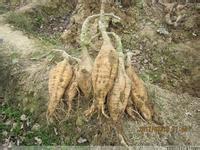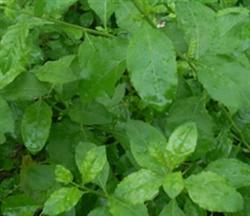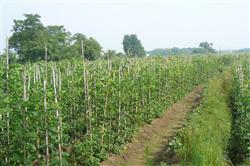Characteristics and artificial cultivation techniques of Wild Pueraria lobata

First, the characteristics. Pueraria lobata has strong adaptability, lax requirements on climate and geographical conditions, and is easy to cultivate. Suitable for warm and humid growing environment. Pueraria lobata likes temperature and heat resistance, and begins to germinate when the average daily air temperature is about 12 ℃. The daily average temperature for growth is 20-33 ℃, 25-30 ℃ is suitable for root formation, and 15-20 ℃ is suitable for starch accumulation in root tubers. Under the climatic conditions of our province, it began to grow at the end of March and the beginning of April, the peak growing season was from May to September, stopped growing in the middle of November, withered after frost, and the open field could survive the winter safely. Kudzu root likes light and is more tolerant to shade. It grows very strongly in sufficient sunlight, with stout stems and more branches. When the light is insufficient, the branches decrease, and the leaves are small and sparse. It grows better in the shade and has strong resistance to high temperature, drought and diseases and insect pests. Resistant to low temperature and severe cold, not resistant to waterlogging. The growth period is 210-240 days. Second, cultivation techniques 1. Site selection. It is suitable to choose sandy loam soil with deep soil layer, loose soil and rich organic matter, but it can also grow on acidic and barren red loam soil; it can be planted on various types of free dry land, such as hillside land, forest cutting land, riverside embankment, field corner, front and back house, or intercropping with large economic forest. It is not suitable to choose low-lying flooded fields for planting. 2. Transplant. There are various propagation methods of Pueraria lobata, including sexual reproduction with seeds and asexual reproduction with stem cuttings and strips. The seedling period is from December last year to January this year, and the planting period is from February to April. Plant 650-750 plants per mu. It can be planted with rooted seedlings or cut with 16-20 cm cuttings with 2 stem nodes. When planting, the seedlings are planted at an angle of 30 degrees from the ground, but the stem nodes must be outside the soil. After planting, pour the root water. It is better to choose cloudy and rainy days when planting. 3. Field management. After planting kudzu seedlings, the soil at the roots should be kept moist. After 5-6 days of planting, pour diluted human feces and urine a little away from the base of the kudzu seedlings. After germination, it is appropriate to protect seedlings and fertilize (rare manure) with a small amount for many times. When kudzu vine grows to 1-1.5 meters, apply rotten pig manure or cow manure once, 2-3 kg per plant, loosen the soil and weed once before or after fertilization, and then weed regularly, and then topdressing again in July-August. Keep the soil moist throughout the growth period, timely drainage in the rainy season, waterlogging and waterlogging prevention. 4. Disease and pest control. Kudzu root has fewer diseases and insect pests. The main reason is that kudi rust is easy to occur when it is planted continuously for more than 2 years, and if it is serious, it can be prevented and treated by spraying methyl topiramate. Insect pests are mainly crickets, but 150 grams of dichlorvos or dimethoate are sprayed on 75 kilograms of water. 5. harvest at the right time. It can be harvested from August to March of the following year, and overdense underground roots are harvested in mid-late August. The main harvest time is winter, when the nutrients are concentrated in the root block, and the root mass expands, so the soil at the base of the plant can be dug directly from the crack on the ground, the root head of the root can be exposed, the big and the small can be harvested, and the soil will be flattened after harvest, leaving the smaller ones in the ground. Wait until next year to continue to grow.
- Prev

It is not suitable for Chinese wolfberry to pick and sun eight.
Chinese wolfberry is a perennial deciduous shrub of Solanaceae. Its tender shoots and leaves (also known as Chinese wolfberry head) are eaten as vegetables, which can be fried, salad, soup, etc., rich in nutrition, delicious and delicious, and are favored by consumers. Lishui County, Jiangsu Province began to introduce planting in 2002, the products are mainly sold to Shanghai, Nanjing, Wuxi and other large and medium-sized cities.
- Next

Key points of cultivation of fast-growing Pueraria lobata
Pueraria lobata is a legume vine, the whole body is a treasure, the economic value is very high. Among them, kudzu powder is a characteristic health food, which integrates nutrition, dietotherapy and delicacy, and deep processing can also be made into more than a dozen kinds of exquisite food; kudzu leaf, which is rich in plant protein, belongs to full-price feed; Pueraria lobata is a valuable medicine and antialcoholic medicine. Pueraria lobata has a growth cycle.
Related
- Fuxing push coffee new agricultural production and marketing class: lack of small-scale processing plants
- Jujube rice field leisure farm deep ploughing Yilan for five years to create a space for organic food and play
- Nongyu Farm-A trial of organic papaya for brave women with advanced technology
- Four points for attention in the prevention and control of diseases and insect pests of edible fungi
- How to add nutrient solution to Edible Fungi
- Is there any good way to control edible fungus mites?
- Open Inoculation Technology of Edible Fungi
- Is there any clever way to use fertilizer for edible fungus in winter?
- What agents are used to kill the pathogens of edible fungi in the mushroom shed?
- Rapid drying of Edible Fungi

